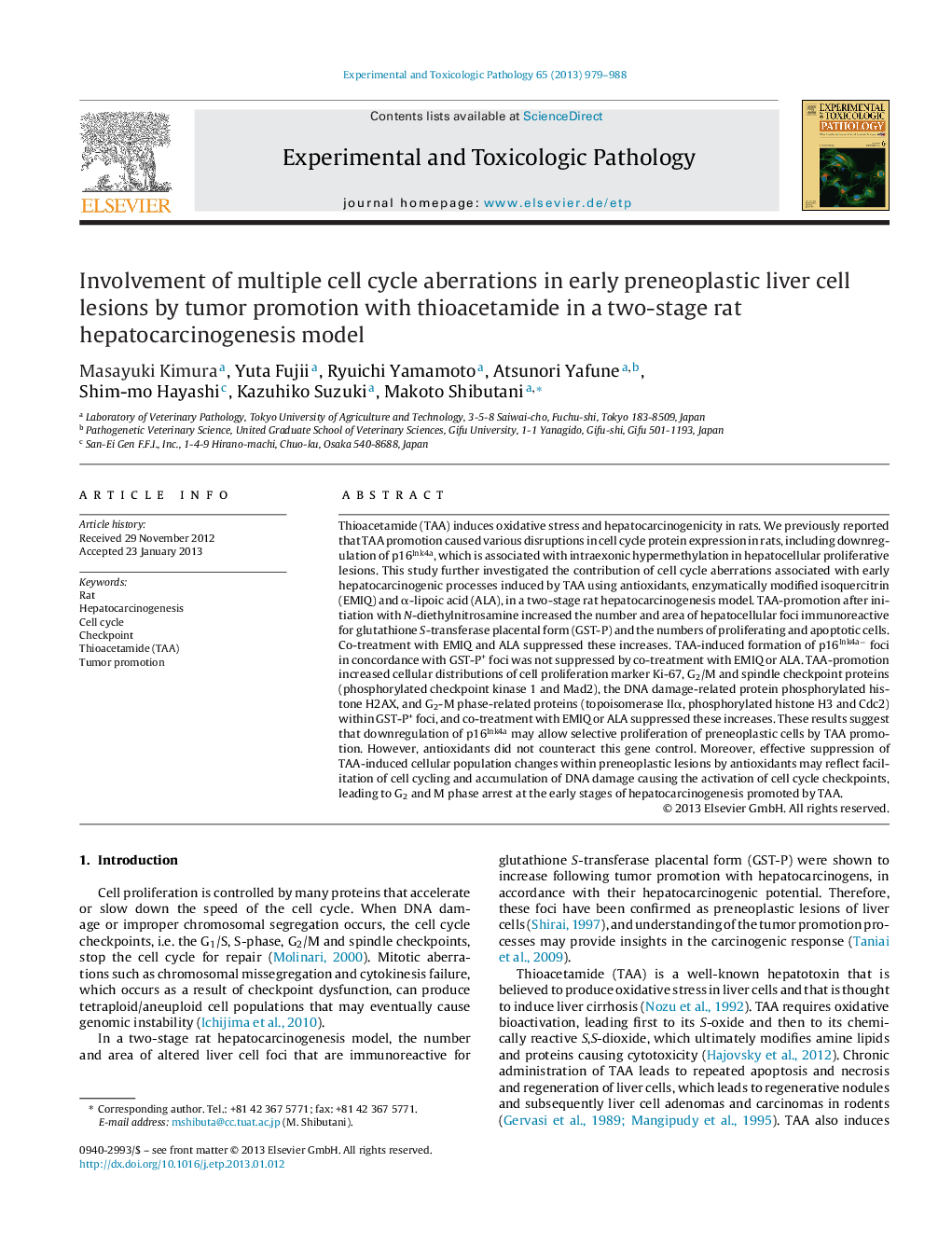| کد مقاله | کد نشریه | سال انتشار | مقاله انگلیسی | نسخه تمام متن |
|---|---|---|---|---|
| 5817169 | 1556838 | 2013 | 10 صفحه PDF | دانلود رایگان |
عنوان انگلیسی مقاله ISI
Involvement of multiple cell cycle aberrations in early preneoplastic liver cell lesions by tumor promotion with thioacetamide in a two-stage rat hepatocarcinogenesis model
ترجمه فارسی عنوان
مشارکت چندگانه سلول های چندگانه در ضایعات اولیه زخم پنیوپلاستی کبد توسط ارتقاء تومور با تیواساتامید در مدل دو مرحله ای از نظر هپاتوکارسینوژنز موش صحرایی
دانلود مقاله + سفارش ترجمه
دانلود مقاله ISI انگلیسی
رایگان برای ایرانیان
کلمات کلیدی
موضوعات مرتبط
علوم زیستی و بیوفناوری
علوم کشاورزی و بیولوژیک
علوم دامی و جانورشناسی
چکیده انگلیسی
Thioacetamide (TAA) induces oxidative stress and hepatocarcinogenicity in rats. We previously reported that TAA promotion caused various disruptions in cell cycle protein expression in rats, including downregulation of p16Ink4a, which is associated with intraexonic hypermethylation in hepatocellular proliferative lesions. This study further investigated the contribution of cell cycle aberrations associated with early hepatocarcinogenic processes induced by TAA using antioxidants, enzymatically modified isoquercitrin (EMIQ) and α-lipoic acid (ALA), in a two-stage rat hepatocarcinogenesis model. TAA-promotion after initiation with N-diethylnitrosamine increased the number and area of hepatocellular foci immunoreactive for glutathione S-transferase placental form (GST-P) and the numbers of proliferating and apoptotic cells. Co-treatment with EMIQ and ALA suppressed these increases. TAA-induced formation of p16Ink4aâ foci in concordance with GST-P+ foci was not suppressed by co-treatment with EMIQ or ALA. TAA-promotion increased cellular distributions of cell proliferation marker Ki-67, G2/M and spindle checkpoint proteins (phosphorylated checkpoint kinase 1 and Mad2), the DNA damage-related protein phosphorylated histone H2AX, and G2-M phase-related proteins (topoisomerase IIα, phosphorylated histone H3 and Cdc2) within GST-P+ foci, and co-treatment with EMIQ or ALA suppressed these increases. These results suggest that downregulation of p16Ink4a may allow selective proliferation of preneoplastic cells by TAA promotion. However, antioxidants did not counteract this gene control. Moreover, effective suppression of TAA-induced cellular population changes within preneoplastic lesions by antioxidants may reflect facilitation of cell cycling and accumulation of DNA damage causing the activation of cell cycle checkpoints, leading to G2 and M phase arrest at the early stages of hepatocarcinogenesis promoted by TAA.
ناشر
Database: Elsevier - ScienceDirect (ساینس دایرکت)
Journal: Experimental and Toxicologic Pathology - Volume 65, Issues 7â8, November 2013, Pages 979-988
Journal: Experimental and Toxicologic Pathology - Volume 65, Issues 7â8, November 2013, Pages 979-988
نویسندگان
Masayuki Kimura, Yuta Fujii, Ryuichi Yamamoto, Atsunori Yafune, Shim-mo Hayashi, Kazuhiko Suzuki, Makoto Shibutani,
